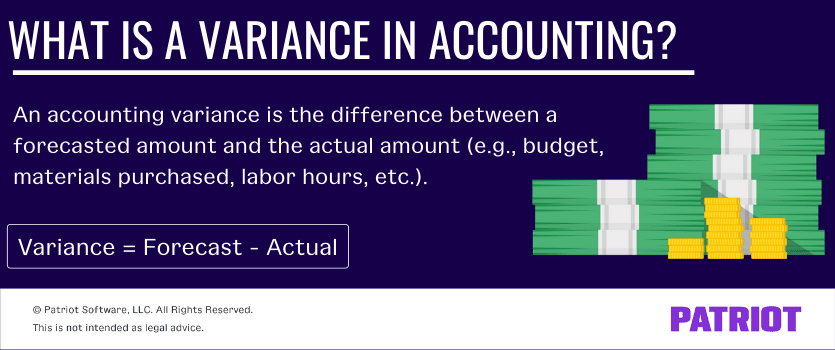Forecasting how much you’re going to spend and receive is a key part of running a business. But, rarely do predictions match actual income and expenses. More than likely, you’ll experience a variance in accounting at some point.
Variances are normal in accounting. But, that doesn’t mean you can’t analyze variances and learn from them. Read on to learn:
- Variance meaning in accounting
- Formula for calculating variance amounts
- How to analyze variances
What is a variance in accounting?
A variance in accounting is the difference between a forecasted amount and the actual amount. Variances are common in budgeting, but you can have a variance in anything that you forecast. Basically, whenever you predict something, you’re bound to have either a favorable or unfavorable variance.

Favorable variances mean you’re doing better in an area of your business than anticipated. Unfavorable variances mean your prediction is better than the actual outcome.
You can have variances in your:
- Budget
- Materials purchased
- Labor hours
- Overhead costs
- Materials produced
- Number of sales
- Revenue
Due to the different types of variances, you might measure variances in dollars, units, or hours.
You can measure your total variance (e.g., your budget as a whole) or break it down (e.g., sales revenue). Finding specific variances can give you a more detailed view of your business’s performance and financial health. Only looking at your total variance could give you a skewed impression of your business’s performance and health.
For example, you could have an overall favorable budget variance. But after breaking down the variances, you notice that your revenue is greater than predicted, but you spent more on materials than anticipated. Using this information, you can shop around for new vendors and cut down unnecessary expenses.
Looking at variance in cost accounting helps you nip problems in the bud that could otherwise go undetected—and snowball into bigger issues.
Variance in accounting formula
Before you can figure out your variance, you need to know how to calculate it. Whether you’re looking at a variance in labor, pricing, or material usage, the formula is the same:
Variance = Forecast – Actual
To find your variance in accounting, subtract what you actually spent or used (cost, materials, etc.) from your forecasted amount.
If the number is positive, you have a favorable variance (yay!). If the number is negative, you have an unfavorable variance (don’t panic—you can analyze and improve).
Want to calculate your variance accounting as a percentage? You can do that, too. Keep in mind that a favorable variance percentage is expressed as a negative number, whereas an unfavorable variance is positive. Here’s the formula to calculate your variance as a percentage:
Variance = [(Actual / Forecast) – 1] X 100
In this formula, divide what you actually spent or used by what you predicted. Then, subtract 1 and multiply the total by 100 to turn it into a percentage.
Variances Formula Example
Want to see these formulas in action? Take a look at our examples to see both the amount and percentage for unfavorable and favorable variances.
Unfavorable variance
Let’s start with the variance amount formula. Say you predict to spend $5,000 on inventory. But, there’s a supply shortage that drives up your costs to $7,000. What’s your variance?
Variance = Forecast – Actual
Variance = $5,000 – $7,000
Your variance is -$2,000, which is an unfavorable variance. What is this amount as a percentage? Use the other variance formula to find out:
Variance = [(Actual / Forecast) – 1] X 100
Variance = [($7,000 / $5,000) – 1] X 100
Your variance is 40%. This shows that your actual cost was 40% greater than your prediction.
Favorable variance
Now, let’s look at a favorable variance example. Say you predicted you would spend 1,000 hours on Project XYZ. Instead, you only spent 500 hours on the project. What’s your variance?
Variance = Forecast – Actual
Variance = 1,000 – 500
Your favorable variance is 500, showing you spent 500 fewer hours on the project than you projected. Here’s that as a percentage:
Variance = [(Actual / Forecast) – 1] X 100
Variance = [(500 / 1,000) – 1] X 100
Your variance is -50%, showing that your actual labor hours were 50% fewer than you predicted.
Variance analysis accounting process
Understand variance in accounting and why it’s important? Check. Now, here’s what to do with that information to help your business.
It’s time to analyze said variance. So, what is variance analysis?
You can conduct a variance analysis of financial statements, hours your employees log, purchase receipts, etc.
Follow these general steps to start your variance analysis in cost accounting.
1. Calculate your overall variance
First, determine what you want to analyze. Is it your annual budget? A project you’re working on? Employee input and output?
Once you’ve decided what you want to measure, calculate the difference between your prediction and actual results.
Is your variable favorable or unfavorable? Regardless of the answer, move on to the next step to get a better picture of where you’re over- or underperforming.
2. Break it down by analyzing specific variances
Take a look at the specific variances for whatever you’re measuring. If it’s your budget, you can start by looking at the differences between your budgeted and actual cost for each of your expenses. And if you’re measuring how long it took you to complete Project XYZ, you could look at the number of hours it took each department compared with your predictions.
Whatever it is you’re breaking down, start by gathering documents to compare actual results to your predictions.
For example, you may need:
- Receipts
- Employee time logs
- Financial statements
Write out each variance to help you analyze your accounting information and make well-informed decisions.
Of course, if you’re off by an insignificant amount (e.g., $20), you probably don’t need to waste time analyzing the reason why.
Keep in mind that there are some challenges that come with looking at specific variances. It can be a time commitment to gather records and sort through information (especially if you’re not using tools like accounting software).
3. Explain the reasons for different outcomes
Here’s where you get to play detective. Why is there a variance? Refer to the specific variances you calculated and look at your records to identify why there could be a difference.
Don’t skip over favorable variances. Sure, it’s great that you’re doing better in said area than you predicted. But by assessing the reason why, you may be able to apply that success to underperforming areas. Not to mention, you can duplicate the success for next time, too.
Take a look at some of the reasons for variances in accounting:
- Supply shortages
- Vendor discounts
- Natural disasters and emergencies (e.g., COVID-19)
- Employee terminations
- Employee absences
- Drop in sales
- Expense cuts
4. Report variances to interested parties
Don’t file away your findings on a shelf to collect dust. Instead, share the information (both the good and the bad) with interested parties, such as:
- Managers
- Employees
- Investors
5. Make improvements to underperforming areas
You’ve put in the time calculating, analyzing, and explaining your variances. Now, it’s time to put that information into action. Use what you learned to make improvements to underperforming areas.
You can use variances to make changes like:
- Getting rid of expenses
- Changing suppliers
- Finding ways to boost sales
- Terminating employees
- Streamlining processes
And, remember to keep a good thing going in over-performing areas, too.
There are two types of people in this world: Those who are organized … and those who are not. But if you want to analyze variances in accounting, you need organized records. With Patriot’s online accounting, you can keep track of your income and expenses all in one place. See how easy it is with a free trial!
This is not intended as legal advice; for more information, please click here.


